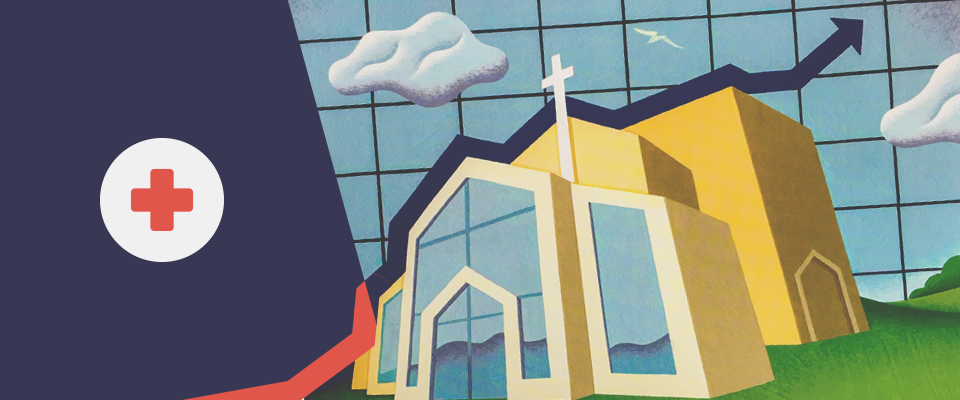Interest Rate Swaps: A Good or Bad Deal for Your Company?
Special thanks to Judith Fellheimer, of Fellheimer and Eichen LLP for providing the article below. We feel this information is timely and relevant for churches whose lenders may have suggested an Interest Rate Swap, as such contracts pose a risk to a ministry's financial health. If you have questions or would like more information, please call us at 866.621.1787.
by Judith Fellheimer
No business executive wakes up in the morning and decides that his Company needs to purchase an Interest Rate Swap ("Swap"). In fact, he probably doesn't even know what it is. What usually happens is that the executive, for whatever reason, needs to ask his bank ("Lender") for a loan and wants the loan at a fixed rate of interest. The Lender, however, prefers to grant the loan at a variable rate of interest. [Here’s where the Swap comes in.] To solve the problem, the Lender suggests that the executive consider turning his Company’s requested fixed-rate loan into a Swap.
What exactly is a Swap? It’s a contract between a Company and an outside investor called a “Swap Party.” The swap contract is separate and apart from the loan agreement with the Company’s Lender. This new agreement enables the Company to pay the Lender at a fixed rate of interest over the life of the loan rather than the floating rate of interest that the Lender prefers. The function of the Swap Party is to accept the Company’s fixed rate interest payments for the five- to 10-year term of the loan, and then make variable rate interest payments to the Lender over the same time period. In other words, the Company pays the Swap Party and the Swap Party pays the lender.
What the business executive doesn’t know is that even though the bank seems to be initiating the Swap, it is actually a separate security with its own profit component. The executive also doesn’t realize that the bank can make more money selling the Swap than it can earn by entering into a direct loan transaction with his Company.
A bank will view any Company looking for a multimillion dollar loan for a term of five or more years at a fixed rate of interest, as a potential prospect for a Swap. The lending officer is trained to paint an attractive picture of the Swap by showing the Company that its interest costs will be lower with a Swap and the longer the swap period, the lower the interest rate. Some banks will not even offer a loan at a fixed rate for any period of time unless the Company takes a Swap.
How Does the Swap Party Benefit from the Swap Contract?
The Swap Party is a speculator who makes a wager that it will profit by taking the fixed rate interest payment from a Company and paying out the variable interest rate payment to the Company’s Lender over the life of the Swap. Depending on the terms of the Swap and the direction of interest rates over the life of the Swap, the Swap Party may or may not make a profit on its Swap wager. As interest rates fluctuate, the Swap Party makes a profit when the fixed rate exceeds the variable rate, and has a loss when the variable rate exceeds the fixed rate.
Swaps are usually only offered to borrowers at times when the Swap Party believes that the movements of interest rates over the term of the Swap will be in its favor. And since Swap Parties are in the business of evaluating the interest rate markets, they are more often right than wrong about the movement of interest rates.
However, the fact that the Swap Party makes a profit on its interest rate wager does not, in and of itself, make the Swap Contract a bad decision for a borrower. After all, if your Company achieves its objective of controlling future borrowing costs, and the Swap Party earns a profit on its interest rate speculation, why wouldn’t it be a good decision for both parties? As I will explain, there is a huge risk for any Company that enters into an Interest Rate Swap—a risk that doesn’t appear on the surface of the transaction.
Will the Real Swap Party Please Stand Up?
When entering into a Swap Contract, a Company is often given the false impression that the party on the other side of the Swap Contract is their Lender, and therefore the Swap Party will have the same interest in the survival of the Company as does the Lender. This is a reasonable conclusion for the Company to reach because the mechanics of presenting and signing the Swap Contract is usually handled by the Lender’s loan officer. In addition, the name of the Swap Party on the Swap Contract is often the same as the name of the Company’s Lender. What isn’t clear to the Company is that even if the name of the Swap Party is the same as the name of its Lender, the Swap Contract and the Loan come from two separate parts of the Lender’s organization, or two separate subsidiaries, with different decision makers and different, even conflicting, business goals. While the lending officer may benefit by adjusting the terms of the Company’s loan in response to a short-term change in business conditions, or may have an interest in continuing the Company as a customer of the bank, the division of the Lender that entered into the Swap Agreement has only one interest: having the Company follow the payment terms of the Swap Contract over its lifetime, or collecting the penalty the Company will be charged for an early termination.
What's the Risk of Loss for the Borrower?
The term of the Swap Contract between the Swap Party and the Company is as long as the loan itself—five to 10 years—or whatever term is specified in the loan agreement. The risk to the Company entering a Swap Contract is that during the long five- to 10-year life of the contract, a change in the Company’s financial circumstances, an unplanned business opportunity, or a change in the financial or political circumstances of the Lender, will cause the Company to terminate the Swap Contract before the end of its term. This is when the Company faces unexpected prepayment and penalty issues.
Below are actual incidents from my practice where my clients were forced to prepay the Swap Contracts and pay an unexpected early termination penalty.
- A client’s manufacturing company (Manufacturer) pledged all of its real estate, inventory and receivables to support its $12 million in bank loans. The real estate portion of the loan was $6 million and that loan was coupled with a Swap. Four years later, the Manufacturer was presented with an opportunity to purchase one of its key suppliers and thereby reduce its overall production costs. But to make this purchase, an additional $4 million in new financing was required. The Manufacturer’s original Lender turned down the Manufacturer’s request for additional financing but the Manufacturer found a new lender who offered to provide the $4 million in new financing to purchase the acquisition, but wanted a lien on receivables. Since the receivables were part of the asset package provided to the first Lender, the Manufacturer had to repay all of its existing financing in order to provide a lien on its receivables requested by the new lender. Therefore, the Manufacturer had to pay off its $12 million loan with its original Lender and enter into a $16 million loan with the new Lender. This repayment of the first lender’s real estate loan prior to its maturity date, automatically caused a premature termination of the Swap Contract, and my client was forced to pay the Swap Party an early termination penalty of $650,000 before his company could accept new financing.
- The owner of a suburban shopping center received a favorable offer to purchase the center. The lender to the shopping center had agreed that if its loan was repaid before maturity as a result of the sale of the shopping center, the lender would not impose a prepayment penalty. However, the shopping center owner had also signed a Swap Contract, and the lender's agreement not to impose a penalty did not include the Swap Contract, and when the sale closed, my client had to pay $1.2 million as a Swap prepayment penalty.
- My client, a used car dealer, had done business with a small local bank for more than five years when the bank was purchased by a much larger regional bank. The regional bank decided that they didn’t want to be in the business of lending to used car dealers and that my client was no longer a desirable customer. The lender began to pressure the car dealer to find another bank by interpreting the dealer’s company’s loan documents more harshly and shrinking the dealer’s line of credit. The dealer soon “got the message” and found another bank to take on his lending relationship. However, even though the bank wanted the dealer to take his banking relationship to another bank, this didn’t affect the dealer’s Swap contract, and the dealer unfortunately was charged an early termination Swap penalty of $250,000 when he changed banks.
Frequently, a bank’s loan officers may be willing to try to work out loan issues with a Company, even if the Company misses a payment. However, the failure to make any payment under the Swap Contract, or the existence of a default under the Company’s loan agreement, will immediately be a default under the Swap Agreement, causing the Swap Agreement to terminate and the termination penalty to be assessed against the Company. So when a Company experiences financial problems, having a Swap makes those problems even worse.
The Swap Agreement Termination Penalty: How Is It Calculated?
Early termination of a Swap Contract is quite common. The penalty that the Company must pay in order to terminate the Swap Contract early is set out (but not easily understood) in the Swap Contract. An approximation of the termination cost is usually equal to the financial benefit that would have been earned by the Swap Partner over the remaining unexpired term of the Swap Contract, plus a break-up fee that can only be calculated by the Swap Party.
An illustration of the financial benefit component of the swap termination penalty would be:
Assume a Company enters into a 10-year 6% fixed interest rate Swap Contract for a $5 million loan. Six years into the Swap Contract the Company wants to terminate the Swap Contract, at a time when the current variable interest rate on the loan is 4.5%. The approximate termination fee would be calculated as: fixed rate of interest (6%) – current variable rate (4.5%) = 1.5% x unexpired term of the Swap Contract (four years) x outstanding balance of the loan ($5 million) = $300,000 penalty!
Assuming that you are the borrower, when the termination penalty is being explained to you by your loan officer, he or she often emphasizes that the termination penalty is a two-way street and either party may terminate the Swap Contract early. The loan officer gives you the mistaken impression that you could just as likely benefit from the early termination penalty as the Swap Party. However, the only circumstance under which you would benefit from an early termination of the Swap would be if the Swap Party is losing money on the Swap Contract, which is a once-in-a blue-moon circumstance.
A Final Word of Advice
If your lender suggests a Swap Contract, my advice is to follow the Nancy Reagan approach: “Just say no!” If your Company is not in a position to say “no” to your Lender, then take the shortest Swap Term offered. Very often your lender will offer you the choice of a five-, seven-, or 10-year Swap, with the fixed interest rate lower with each longer period of time. Always take the shortest Swap Term offered. The longer the Swap, the more likely you are to encounter an unforeseen circumstance that will cause you to prepay your loan and trigger a substantial penalty for the early termination of the Swap Contract.
Judith Fellheimer is a partner in the Business Litigation and Financial Services Practice Groups at the law firm of Fellheimer & Eichen LLP.
Used with permission.



